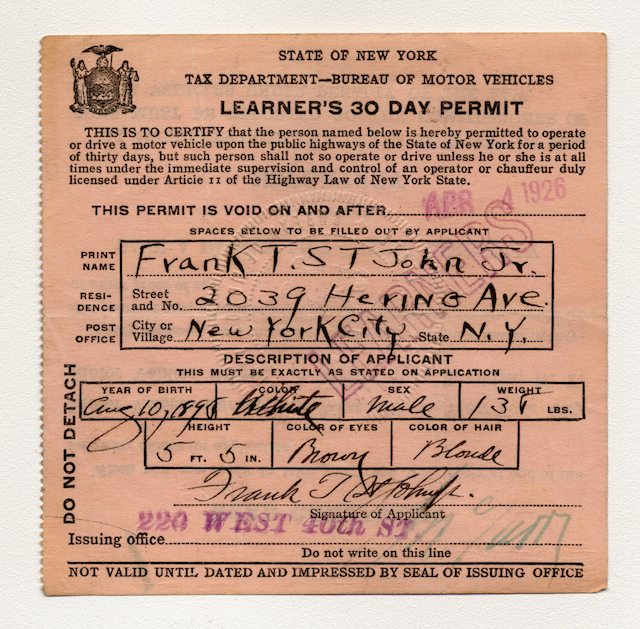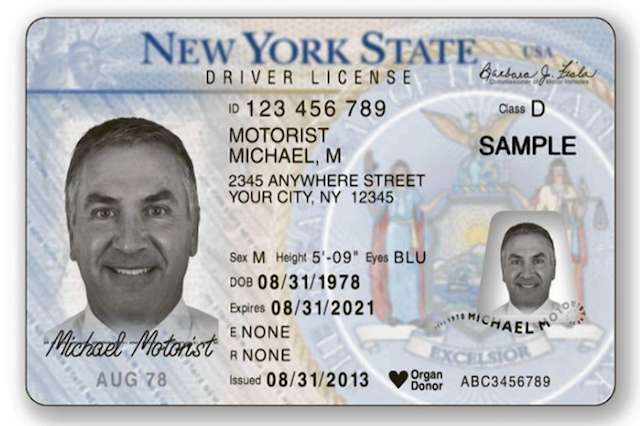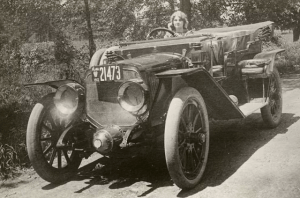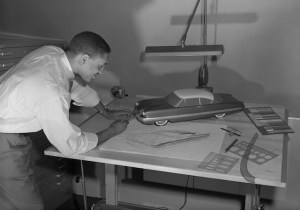There are few moments more memorable than the first time you get your hands on your own driver’s license.
It means you’re finally able to hit the open road on your own — and who doesn’t fondly recall their debut foray behind the wheel? For most of us, this milestone occurs at a formative age, so a driver’s license holds much more significance than simply providing evidence you can properly operate a car. It bestows on its owner a sense of maturity, pride and freedom.
But driver’s licenses didn’t always have this much power. In fact, they didn’t even exist when cars first hit American roads, and when the first licenses were issued, they weren’t used to prove a motorist was a capable driver. By and large, anyone with a pulse and a car could obtain one.
Let’s retrace the history of the driver’s license to see how things have changed.

When Was the First Driver’s License Issued?
Licenses were not required to operate a horse and carriage back in the day. So when automobiles – or horseless carriages, as they were known – arrived on the scene, not much thought was given to ensuring motorists could, in fact, safely drive a car.
In 1903, Massachusetts and Missouri became the first two states to require a driver’s license in order to operate an automobile. However, potential license owners did not have to pass an exam. It would take another five years until Rhode Island became the first state to require license owners to pass a written driver’s exam.
In 1913, New Jersey made history by requiring both written and road tests for those seeking a license. “I confidently believe that other states will follow New Jersey’s lead and that the results will be fewer accidents and better road conditions,” Job H. Lippincott, the state’s motor vehicle commissioner, said at the time.
But adoption of both driver’s licenses and exams was slow to take hold across the country. By 1930, just half of the then 48 states required a license to operate a motor vehicle. Of those, only 15 had mandatory driver’s exams. It wasn’t until 1954 that South Dakota became the final state to issue driver’s licenses. It was also the last to require a driver’s exam, which it did in 1959, following in the footsteps of latecomers Arizona (1951), Idaho (1951), Illinois (1953), Alaska (1956), Wisconsin (1956) and, most notably, Missouri (1952). That’s right – Missouri went nearly a half-century between issuing its first driver’s license and requiring licensees to pass a driver’s exam.
Modern Driver’s Licenses
Today there are numerous types of licenses for vehicle operators including unrestricted (a typical license), provisional (usually for new drivers), commercial and motorcycle.
Because driver’s licenses are also used as de facto forms of identification in the U.S., new types of licenses that meet higher security standards have been created. Enhanced driver’s licenses not only prove identity and driving privileges, but also U.S. citizenship. These cards contain a Radio Frequency Identification chip that allows authorities to access your biographic and biometric data. Americans can travel to Canada, Mexico and the Caribbean through land or sea without a passport if they have an enhanced driver’s license.
The most recent type of license is the REAL ID. These licenses have higher security standards than a traditional license, meaning individuals have to provide documents proving their identity, residency and Social Security number. Beginning in May 2023, those without a REAL ID, an enhanced driver’s license or other acceptable forms of identification won’t be able to board a domestic flight or enter a federal building.
Looking to upgrade your license to a Real ID? AAA members in Massachusetts, Rhode Island and New York can apply at certain local AAA branches. Reserve your spot online ahead of time at AAA.com/Reservations.
Security Features
Because driver’s licenses have become such important documents, states have equipped them with a number of enhanced security features. These help prevent criminals from creating fake or altered license cards. Some of these features include:
- Hologram: Most of today’s driver’s licenses have a hologram that can be viewed at an angle. The hologram is often an image of the state seal or flag.
- Tactile Print: Raised printing is often used on driver’s licenses to write numbers, such as dates of birth, ID numbers or expiration dates.
- Microprinting: As the name suggests, this security feature consists of very small type somewhere on the card. It usually requires a magnifier to read and is often disguised within a pattern, meaning you may not even know it’s there.
- Laser Perforation: This technique makes small holes in the card to form an image, such as the outline of a state. The image can be seen when viewed in direct light.
- Ultraviolet Ink: An image printed in ultraviolet ink will glow when ultraviolet light is shined on the card.

The Decline of the Driver’s License
Nearly 230 million Americans held a valid driver’s license in 2019, a record high and roughly 60 million more than in 1990. But that number is deceiving, as owning a license has become significantly less common. It turns out, teenagers aren’t as keen on getting behind the wheel as their forbearers. In 1984, 47.8 percent of 16-year-olds in the country owned a driver’s license. That number dropped to 25.6% in 2018. In the past few decades states have instituted laws and restrictions for motorists under 18 years of age.
But this trend holds true for adults as well. Through the age of 39, fewer Americans, by percentage, are getting their license. Obtaining a driver’s license has long been a rite of passage in this country, so why the change of heart? In one survey asking unlicensed 18- to 39-year-olds why they did not have a driver’s license, respondents’ answers included being too busy to get one, the high cost of owning and maintaining a car, and preferring biking, walking or public transportation.
Or maybe potential drivers are just afraid of the dreaded roundabout.
Do you remember getting your driver’s license? Tell us about it in the comments below!
Are you a new driver ready to get your driver’s license and hit the open road? Enroll in AAA Driver Training at AAA.com/DriverTraining.
10 Thoughts on “The History of the Driver’s License”
Leave A Comment
Comments are subject to moderation and may or may not be published at the editor’s discretion. Only comments that are relevant to the article and add value to the Your AAA community will be considered. Comments may be edited for clarity and length.














How how to drive in Ohio in 1977 ? Age of temporary permit and full license?
Can anyone tell me when Missouri driver’s licenses were first laminated? Were they ever just paper documents?
I am interested in the drivers license number. I have found no information what that number exactly means. 1 Letter followed by nine numbers. Is this a code of numbers, do they have any significance or are they just random?
Thanks,
Bonnie
I would like to have some information regarding an Enhanced Driving License.
What is the purpose of using this addition to the license and is it actually in place of using a PASSPORT in the nation? Has it been done away with or delayed having this do to the COVID?
Hi Carolyn, thanks for your question. An Enhanced ID allows you to return to the US by land or sea from Canada, Mexico and some countries in the Caribbean. It is also REAL ID compliant and thus can be used in lieu of a passport to board a domestic flight. The Real ID deadline has been pushed back to May 3, 2023. At that time you will need a Real ID, Enhanced ID or passport to fly on a domestic flight. You can find more info here: https://magazine-northeast-aaa-com-staging.go-vip.net/daily/travel/air-travel/what-is-real-id-everything-you-need-to-know-about-the-new-law/
My mother took me to get my driver’s license when I was 16 after I had completed the required driver’s ed course and had spent many evenings and Sundays in parking lots learning how to drive a manual shift car, parallel park (destroying some beach chairs in the process) and other maneuvers. I remember telling my mother that if I was ready for the test to get my driver’s I could drive to the DMV. She couldn’t refute that reasoning so I got behind the wheel, drove to the DMV and easily passed the test.
When my son got his drivers license my first piece of advice to him was this;
Imagine the dumbest person you’ve ever met…now imagine then behind the wheel of a car…because they’re out there.
He’s been driving now for ten years and is a very safe driver….but he also knows that’s not enough, you have to watch what other people are doing and never assume they’re going to do the right or the intelligent thing….sadly that’s the reality of driving.
At 16, I didn’t have the means to pay for driving school, or a vehicle, so I was in no rush to get a license. As I got a little older, I realized how crazy people drive and was in even less rush to get my license. I ended up getting it purely out of necessity at the age of 32!
I got my drivers lic. When I was doing volunteer work in East Los Angels. I was there for a year and never got on a freeway.
When I went for my driver’s test, my father bet another dad that I would fail, but I passed. He lost some money that day. I guess he figured that since y brother had to try twice before he passed that I would too. After all, in his mind, the men should be doing the driving.